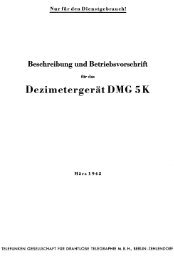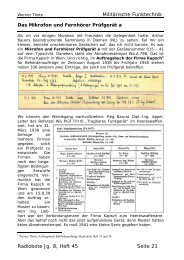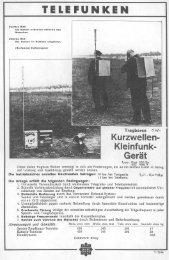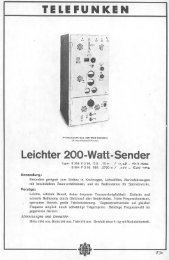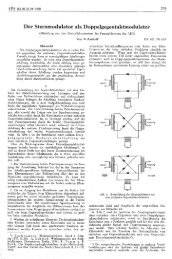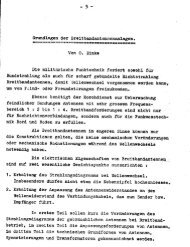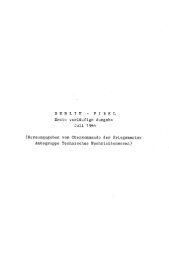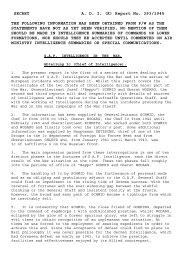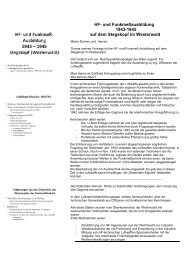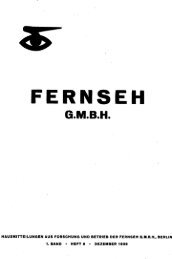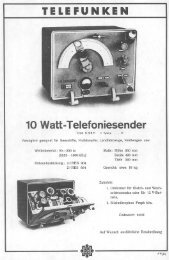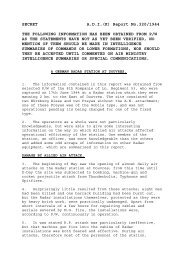SECRET A. D. I. (K) Report No. 357/1945. THE ... - Cdvandt.org
SECRET A. D. I. (K) Report No. 357/1945. THE ... - Cdvandt.org
SECRET A. D. I. (K) Report No. 357/1945. THE ... - Cdvandt.org
Create successful ePaper yourself
Turn your PDF publications into a flip-book with our unique Google optimized e-Paper software.
45. Erika was based on the principle of a V.H.F. (30 - 33 mc/s) beam oscillating rapidly over a<br />
segment of about 60 – 90°. The beam was phased, a different phase being picked up in different<br />
sections of the segment and read off in relation to a standard phase producer in the aircraft. In<br />
order to obtain a fix, two such Erika stations had to be received and to receive each station no<br />
less than two E.B.L.3's were necessary making a total of four receivers.<br />
46. The range presentation unit in the aircraft, FuGe 121, took the form of a clock-face with a<br />
needle indicator and calibrated, P/W thought, from 0 -100. A specially prepared map was<br />
required to establish bearing.<br />
47. A disadvantage of Erika was the vulnerability to jamming, interference signals modifying<br />
the phase and thereby giving inaccurate readings. The great weight, carried and the bulk of the<br />
four receivers, which were particularly cumbersome in the relatively small aircraft in use in the<br />
G.A.F. made its widespread use impracticable.<br />
Bernhardine.<br />
48. This system was first introduced in 1942 for use by bomber aircraft, but was later dropped<br />
in favour of the Benito and Egon control systems. With the increasing British jamming during<br />
night raids it was reintroduced for use in night fighter commentary (see A.D.I.(K) 125/1945,<br />
paras.5 to 29), which it was thought could only be jammed with great difficulty.<br />
49. The term “Bernhard” was used for the ground stations whilst the airborne recording<br />
equipment was called Bernhardine or FuGe 120. The latter made use of the E.B.L.3. receiver as<br />
the transmissions lay in the 30-33 mc/s band.<br />
50. At the time of the German capitulation, the following three transmitting stations were in<br />
operation, the first two, of which could transmit commentary.-<br />
-Thisted, on N.W. coast of Denmark.<br />
-Bretstedt, N. of Husum, Germany.<br />
-Trebbin, S.E. of Berlin.<br />
51. A further station near Breslau had been almost completed when it had to be dismantled on<br />
account of the Russian advance. Additional stations were in the course of construction near<br />
Kassel, Munich, Pilsen and Vienna.<br />
52. The Bernhardine system was looked upon as a considerable improvement on Erika. It gave<br />
360° coverage as compared to 60/90° with Erika and, whereas from the jamming aspect stray<br />
signals could disturb the phase of Erika causing false indication, in the case of Bernhardine,<br />
interference merely resulted in no reading being possible, and furthermore to attain this through<br />
360° a very powerful jamming transmitter flying near the ground station would be needed.<br />
53. The Bernhardine system was not regarded as unjammable but it was thought that use of<br />
high power and aerial gain would render jamming by airborne means impracticable.<br />
54. In addition to the E.B.L.3 receiver, the airborne Hellschreiber FuGe 120, also called the<br />
Bernhardine, which gave both bearing and commentary was employed. According to P/W the<br />
FuGe 120 was large and weighty and the first improvement aimed at was to reduce the weight<br />
and provide a set which occupied less space in the aircraft. To this end an attempt was made to<br />
eliminate the use of paper strip for the Hellschreiber and a rotating "Folienschreiber" a



